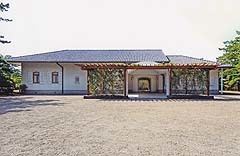 | ||
Similar Numazugoyotei Memorial Park, Tōgū Palace, Hayamashiosai Park, Nikko Tamozawa Imperial, Ōmiya Palace | ||
Hayama imperial villa kanagawa prefecture japan 2016 h27 3 29
Hayama Imperial Villa (葉山御用邸, Hayama Goyōtei), located in the town of Hayama, Kanagawa Prefecture, Japan is a residence owned by the Japanese Imperial Family, and used on infrequent intervals as an informal winter retreat.
Contents
- Hayama imperial villa kanagawa prefecture japan 2016 h27 3 29
- Map of Japan E38092240 0111 Kanagawa ken Miura gun Hayama machi Isshiki 2038 E89189E5B1B1E5BEA1E794A8E982B8
- Hayama imperial villa from seakayak 2675 2015 6 23 tue
- History
- References
Map of Japan, %E3%80%92240-0111 Kanagawa-ken, Miura-gun, Hayama-machi, Isshiki, 2038, %E8%91%89%E5%B1%B1%E5%BE%A1%E7%94%A8%E9%82%B8
Hayama imperial villa from seakayak 2675 2015 6 23 tue
History
The Imperial Family of Japan previously had residences in several locations within Kanagawa Prefecture:
The Hayama Imperial Villa was acquired by the Imperial Household Agency in 1894. It is located on the east bank of Sagami Bay in central Miura Peninsula, just south of Kamakura. The villa was a favorite of Emperor Taishō and he often visited to convalesce from his illnesses and to escape from the stresses of his official duties in Tokyo. Emperor Taishō died at the Hayama Imperial Villa in December 1926. The villa was subsequently used by Emperor Shōwa, who also built a marine biology laboratory on its grounds. Research from the laboratory has resulted in a number of technical monographs. The Imperial Family traditionally uses the Hayama residence in February–March, the season when few tourists visit the area.
The villa was burned down in 1971 in an act of arson and was rebuilt as a one-story building of western architectural design. A portion of the grounds was donated to the town of Hayama at that time, and is now the Hayama Shiosai Park, with a traditional Japanese garden and teahouse, and a small museum displaying part of Emperor Hirohito’s collection of marine specimens from Sagami Bay.
